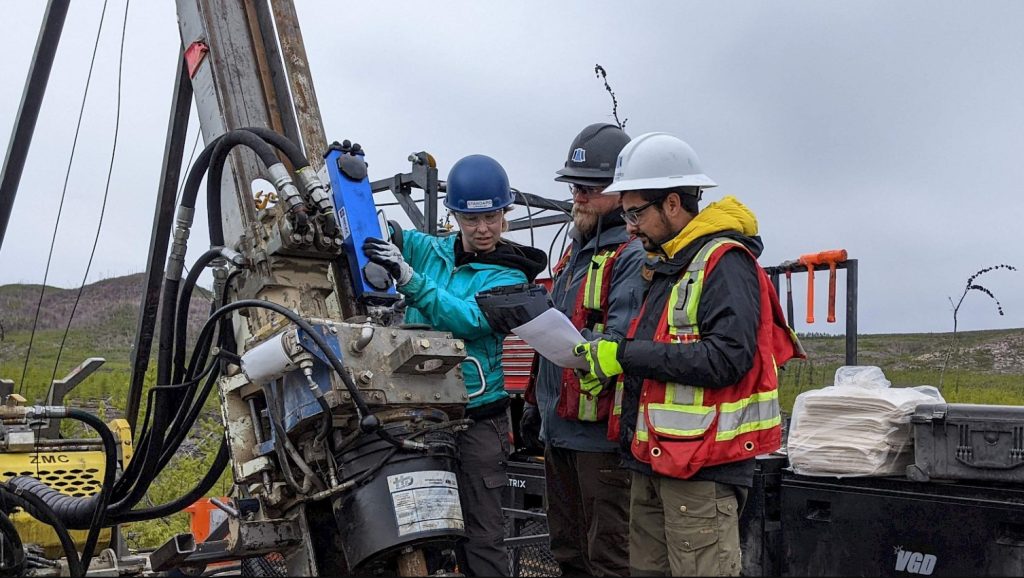Standard Uranium drilling Sun Dog Project, Saskatchewan

Standard Uranium Ltd. [TSXV-STND; OTCQB-STTDF; FSE-9SU0] reported that drilling has begun at the company’s 48,443-acre Sun Dog Uranium Project located near Uranium City, northwestern Saskatchewan. Field crews have arrived at the project and drilling has commenced on schedule.
The project is currently under a three-year earn-in option agreement with Aero Energy Ltd. [TSXV-AERO] executed October 20, 2023. The program will be funded by Aero and will be operated by Standard Uranium.
Highlights – Drilling began July 23, 2024. Approximately 1,000-1,200 metres are planned across 5-7 drill holes targeting shallow high-grade1 basement-hosted uranium mineralization, beginning with the Wishbone target area.
Drill plans comprise helicopter-supported diamond drilling focused on high-priority uranium targets refined by geophysical work completed by the company earlier this year, bolstered by recent prospecting and identification of strong radioactivity at surface within ideal uranium host rocks.
One diamond drill will focus on high-priority target areas along refined VTEMTM corridors with the proven exploration thesis of focusing on major conductor trends associated with cross-cutting faults and surficial radioactivity expressions.
Aero Energy will be funding 100% of the program to meet the year-one expenditure requirements under the option agreement.
The company considers uranium mineralization with concentrations greater than 1.0 wt% U3O8 to be “high-grade”.
“The team and I are thrilled to announce that the drill is spinning on our exciting new Wishbone target area, kicking off our summer exploration season,” said Sean Hillacre, President & VP Exploration.
Diamond drilling the first hole is underway. The summer program will comprise approximately 1,000-1,200 metres of drilling at high-priority target areas following completion of a VTEM Plus survey and geophysical modeling earlier this year.
Sun Dog covers 48,443 acres in nine mining claims, located 15 km from Uranium City on the northern margin of the Athabasca Basin. It hosts the historical Gunnar Uranium Mine that was discovered in 1952 and became the largest uranium producer globally in 1956. The Gunnar Mine produced approximately 18M lbs of U3O8 between 1953 and 1981.
Recent prospecting and mapping at the Wishbone, McNie, and Spring-Dome target areas outlined multiple outcrops of favourable uranium host-rocks, including graphitic pelite, which is commonly radioactive over >200 metres of collective strike length. Structural measurements and radioactivity mapping has further refined drill targets in these areas.
Wishbone Target Area: Approximately 5 km of strike length along a regional scale anticline, defined by strong VTEM conductors with associated radioactivity that has never been drill tested.
Graphitic pelitic rocks have been mapped along both fold limbs, hosting strong radioactivity up to 22,300 cps. Mineralized cross-cutting faults have been mapped in the overlying rocks which intersect the uranium-bearing graphitic pelite unit.
Historical outcrop sampling at the northwestern graphitic pelite exposure returned assay results of 0.32% U3O8 and 0.30% Cu (SMDI #2095).
McNie Target Area: Approximately 4 km of untested VTEM conductor strike length. The corridors are off-set by significant E-W trending regional faults, which host known uranium showings to the east towards the newly discovered zone at target H15 on the Murmac Project, and to the west towards the past-producing Gulch uranium mine.
Spring-Dome Target Area: Historically explored Gunnar-style target focused on mineralized carbonatized granites and pitchblende veins and fractures.
The Spring-Dome area has been historically drilled with intersections over 1.0% U3O8; however, several showings of uranium south of known drilling with values up to 17.4% U3O8 and radioactivity readings >65,535 cps have not been properly drill-tested.
The company is y evaluating the priority of this area through prospecting, mapping, and geological modeling. The target area south of Spring Lake represents the possibility of a uranium deposit akin to the nearby past-producing “Beaverlodge-style” Gunnar mine.
Other high-priority target areas including Haven, Java, and Skye are being reviewed with new datasets and models for a possible winter drill program in 2025.
The company considers radioactivity readings greater than 300 counts per second (cps) to be “anomalous”.
Historical data disclosed in this news release relating to sampling results on the Sun Dog Project is historical in nature. The company’s future exploration work will include verification of the data.
Standard Uranium is a uranium exploration company and emerging project generator poised for discovery in the world’s richest uranium district. The company holds interest in over 209,867 acres (84,930 hectares) in the Athabasca Basin.
Standard Uranium has successfully completed three joint venture earn in partnerships on their Sun Dog, Canary, and Atlantic projects totaling over $23.8M in work commitments over the next three years from 2024-2027.
Standard Uranium’s Davidson River Project, in the southwest part of the Athabasca Basin, Saskatchewan, comprises 10 mineral claims over 30,737 hectares. Davidson River is highly prospective for basement-hosted uranium deposits due to its location along trend from recent high-grade uranium discoveries.
Standard Uranium’s eight eastern Athabasca projects comprise 30 mineral claims over 32,838 hectares
Standard Uranium’s Sun Dog project, in the northwest part of the Athabasca Basin, is comprised of nine mineral claims over 19,603 hectares. The Sun Dog project is highly prospective for basement and unconformity hosted uranium deposits yet remains largely untested by sufficient drilling despite its location proximal to uranium discoveries in the area.
